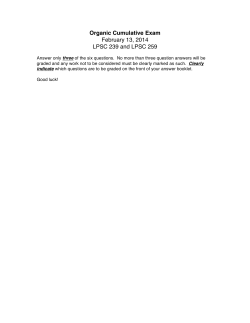
Organic Chemistry I NAME CHM 223 FALL 14 (neatly!)_____________________________
Organic Chemistry I CHM 223 FALL 14 TEST 1 NAME (neatly!)_____________________________ 1. Element Q has the Lewis dot structure shown. Which element from the following would it behave most like? Q A. C-1 B. O C. F+1 D. Li-2 E. N+1 2. Carbon and hydrogen have nearly identical electronegativities. Draw the Lewis dot structure for BH2Cl and the direction of the individual bond dipoles using the proper arrow conventions. 3. From the structure in question 2, is the molecule expected to have a net dipole moment? If so, indicate the direction of the dipole moment using the proper arrow convention. 4. Provide any necessary formal charges on the structure below. ALSO, what is the overall charge on the molecule?: S N O 5. The following molecule has 3 possible resonance forms (A, B and C). Draw the curved arrows that convert A to B. Use curved arrows to draw the remaining important contributing resonance form C from B. HINT: draw in lone pairs before starting. H 2N H 2N O O A B C 6. Three resonance forms for a compound are provided below. Rank them according to their expected contribution to the hybrid form by the resonance form that contributes the MOST (i.e., most stable) to the resonance form that contributes the LEAST (i.e. least stable). Briefly Explain. N N N O O O B A C 7. Draw the structure of 2-chloro-3,4-diethyl-5-(isopropyl)octane using the skeletal (bond-line) format below: 8. Provide the complete IUPAC name for the following compound: Br 9. Compound A has a pKa of 12 and compound B has a pKa of 8. Which compound has the most stable conjugate base? Briefly explain. 10. The structure of ibuprofen is provided below. How many SP3 hybridized atoms are present? OH O ibuprofen 11. How many primary (1°) hydrogens are present in ibuprofen? How many tertiary (3°) carbons? 12. Which one of the bold protons in the compound below is expected to be MOST acidic? which is LEAST acidic? H H H 2C P H O MOST: H LEAST: BH 13. What is the relationship between the following two molecules: CH 3 H 3C A. stereoisomers B. constitutional isomers C. identical D. second cousins CH 3 H 3C 14. Rank the following compounds according to their predicted boiling points (highest>>> lowest): OH O OH B A OH OH D C E 15. Two isomeric alkanes, compound X and compound Y, differ in the amount of branching found in their structures. Compound X has a heat of combustion of 2014 kJ/mol and compound Y 2026 kJ/mol. Which compound has the greater amount of branching? Briefly explain. 16. A Newman projection for a compound is shown below. Using appropriate Newman projections, draw and LABEL the MOST stable conformation for this molecule and the LEAST stable. CH2CH 3 H 3C CH2CH 3 H H CH 3 H H CH 3 most stable CH2CH 3 H CH 3 least stable 17. Which ONE of the following statements is TRUE? A. B. C. D. E. the most stable conformation of cyclobutane has high angle strain and no torsional strain the most stable conformation of cyclopropane has high angle strain and high torsional strain the most stable conformation of cyclopentane has no angle strain and high torsional strain the most stable conformation of cyclohexane no high angle strain and high torsional strain the most stable conformation of cyclopentane has no angle strain and no torsional strain 18. Which of the following represents trans-1-ethyl-3-methylcyclohexane in its LEAST stable conformation? A B C D 19. Draw the most stable chair conformation for compound X using ONE of the templates below (CLEARLY indicate your final answer. The additional chairs are present only for trying out different situations): compound X 20. For the substituted cyclohexane compound given below, circle the substituents that will sterically interact with the bold methyl group in a 1,3-diaxial fashion. CH 3 F H Br Cl H F H F Cl Br Br
© Copyright 2025





















